Streetside garden is greening up and filling in
After last summer’s heat and drought, many local readers, I suspect, are ripping out burned-up lawn along the street and replacing it with drought-tolerant plants and hardscaping. That’s what I did a year ago with my own curbside lawn, putting in a decomposed-granite parking strip edged with chopped limestone and pushing back the lawn by several feet to make a pretty, deer-resistant garden of grasses, salvia, garlic chives, yucca, and catmint. Earlier this spring I added a broad decomposed-granite path behind the bed to eat up even more lawn, plus give access to the side-yard gate from the driveway.
It’s all filling in and greening up again for spring. This little curbside garden makes me very happy every time I drive home and see the salvia flowering and the feathergrass blowing in the breeze.
The deer leave alone everything in this bed except the softleaf yucca, which they will sometimes rub their antlers on in autumn and crop the flower spike in spring. A weekly application of deer repellant spray helps prevent that during those times. Other plants include Texas sotol (Dasylirion texana), Mexican oregano (Poliomintha longiflora), Autumn sage (Salvia greggii), Mexican feathergrass (Nassella tenuissima), garlic chives (Allium tuberosum), purple sage (Salvia offinalis purpurea), lamb’s ear (Stachys byzantina ‘Helen Von Stein’), possumhaw holly (Ilex decidua), catmint (Nepeta), datura (Datura wrightii), Muhlenbergia ‘Pink Flamingos,’ bamboo muhly (Muhlenbergia dumosa), and an annually replaced purple fountain grass (Pennisetum setaceum ‘Rubrum’).
In February, when I had the path installed behind my curbside bed, I created this bed for my neighbor Donna. Edged in the same chopped limestone, with a shared decomposed-granite path flowing between our properties, her new streetside bed blends with mine for a harmonious look. It was just planted this spring, but it’s already filling in nicely.
On the other side of my front yard, I also put in this shared bed with my other neighbor, Dell. It looks a lot better than the patchy, brown grass we replaced. We both get to enjoy this bed, which occupies the narrow strip between our two driveways.
All three of these streetside beds are meant to blend with the island berm I planted two years ago, after pulling out the Asian jasmine groundcover that once swathed the entire bed. The silver-and-gold garden contains ‘Color Guard’ yucca (Y. filamentosa ‘Color Guard’), softleaf yucca (Y. recurvifolia), gopher plant (Euphorbia rigida), Mexican feathergrass (Nassella tenuissima), Mexican oregano (Poliomintha longiflora), foxtail fern (Asparagus densiflorus ‘Meyersii’), bamboo muhly (Muhlenbergia dumosa), Texas dwarf palmetto (Sabal minor), heartleaf skullcap (Scutellaria ovata), ‘Sparkler’ sedge (Carex phyllocephala ‘Sparkler’), Turk’s cap (Malvaviscus drummondii), variegated Miscanthus grass, majestic sage (Salvia guaranitica), silver Mediterranean fan palm (Chamaerops humilis var. argentea), Artemisia ‘Powis Castle,’ copper canyon daisy (Tagetes lemmonii), spineless prickly pear (Opuntia), rosemary (Rosmarinus officinalis), Lindheimer nolina (Nolina lindheimeri), and Texas nolina (Nolina texana). I usually also add annual ‘Senorita Rosalita’ cleome and red cordyline for long-season, drought-tolerant color.
The yuccas are trying to bloom. The deer already ate the bloom spikes of one of my softleafs and my neighbor’s red yucca (Hesperaloe), but I’m hoping to protect this one with deer repellant.
And now I’ve got to protect this little ‘Color Guard’ too as it tries to bloom. Wish me luck!
All material © 2006-2012 by Pam Penick for Digging. Unauthorized reproduction prohibited.


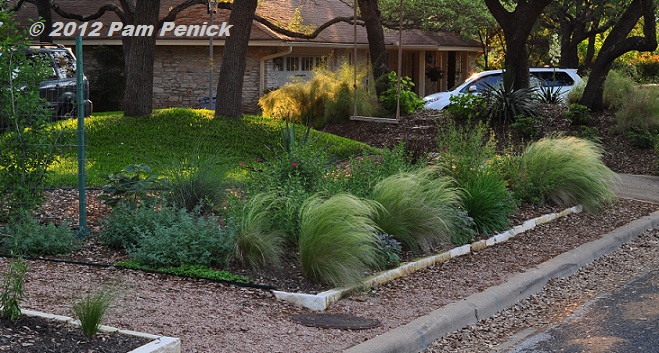
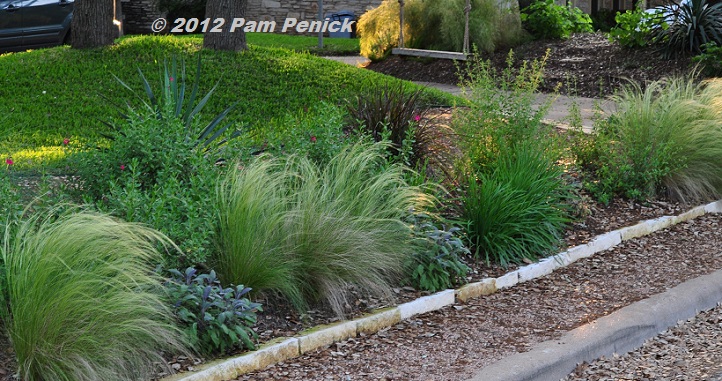
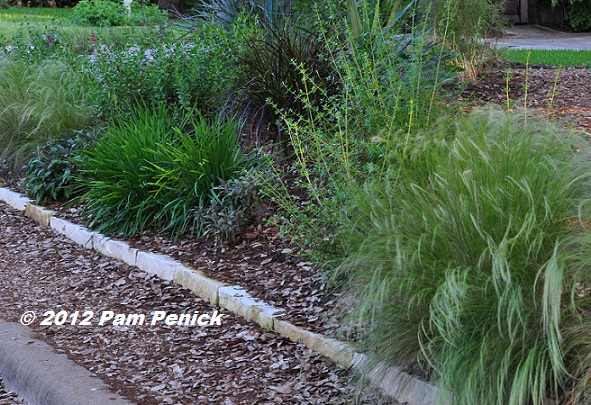
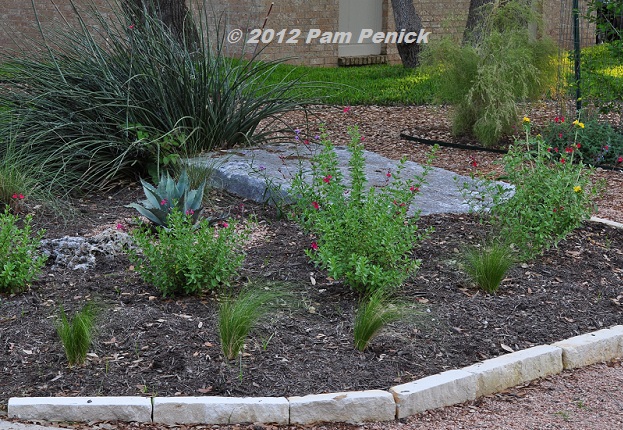
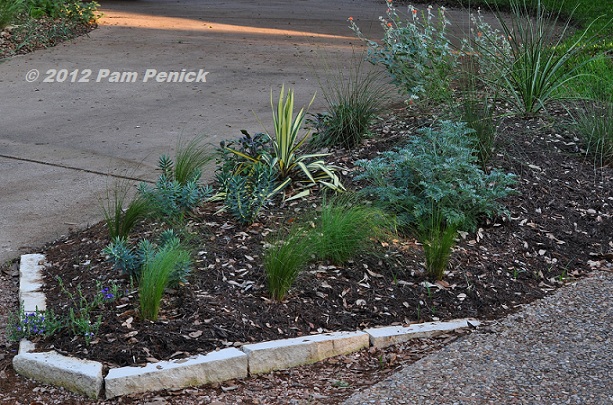
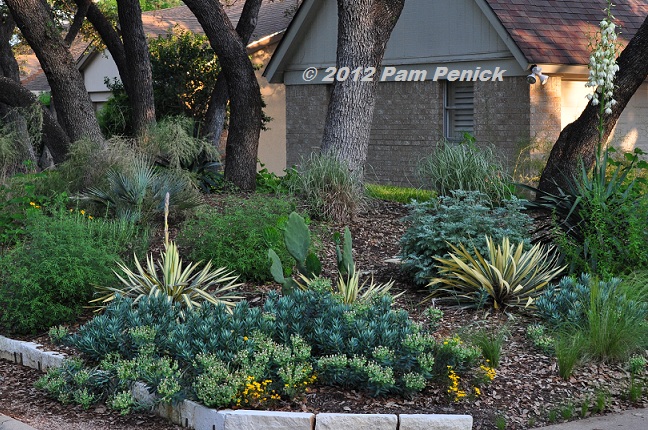
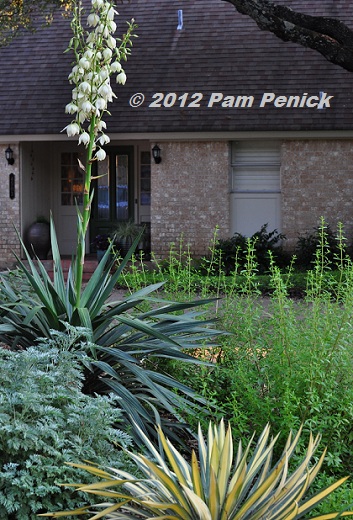
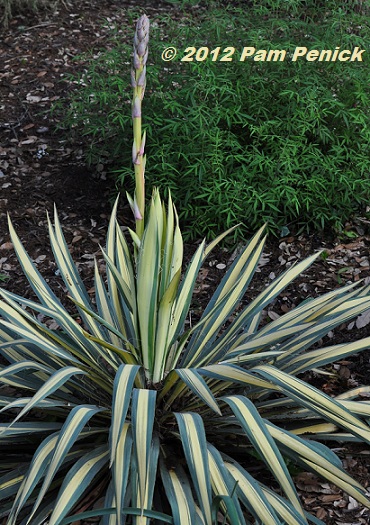
Your front gardens are so beautiful, Pam! I bet all the neighbors on the street love driving/walking by your home. I remember your old posts of these areas – what a transformation!
It’s coming along, Heather. The garden gives me opportunities to visit with the neighbors too. —Pam
It’s looking very good Pam. So much nicer to smile when you drive up. After three years or so, I’m doing the same here. That’s a good use for deer repellent. I can’t see spraying everything all the time, but they love those stalks on plants they otherwise leave alone so I will try that.
I agree, Shirley. It’s no use trying to spray everything with deer repellant all the time. I don’t want to net the plants either, which detracts from the beauty of the garden, in my opinion. So I remove plants that deer have a taste for and add more of the plants that they ignore. Spraying one or two plants to prevent seasonal depredations is a tradeoff I’m willing to make. —Pam
You have a lovely garden. I would like to invite you to follow my blog: http://gardeningupstream.blogspot.com/
Pam..in one of your posts can you post a photo showing the whole front of the house from the street so we can get and idea of the whole vista??
This looks great and I’m impressed that you are having so much luck keeping the deer away.
One of these days I will, ChrisF—after the house gets a much-needed paint job, and I remember not to park the cars in the drive, and the neighbors’ teens aren’t parking along the street in front of my house! I’ve learned to be creative with the cropping of my photos. 😉 —Pam
It’s all coming along really well. And, I bet the neighbors are glad to have you next door.
Good luck with the deer repellent. I always spray things when I plant them….seems anything new is too tempting. Sometimes it works, sometimes not. It’s always worth the try.
Yes, I often do spray a newly planted plant too, Linda. Just once, to give it time to set its roots in the ground before being tasted or pulled at. —Pam
This is such an inspiration. I see a ton of ideas for our landscaping. The drought killed all but a few sprigs of the Asian jasmine, so we will rethink our front flower beds.
Last year, Pat and I planted several drought-resistant plants in our “circle” garden. I was certain we had lost all except the blackfoot daisies. Several plants did die, however, while pulling some weeds today, I discovered our Copper canyon daisy! I was so excited! All of the other, more established plants we had in that bed have weathered cold and drought, including: turk’s cap; skull cap; Russian sage; lemon verbena; Mexican petunias; society garlic; and gray santolina. We barely watered that bed last year, especially after the extreme heat set in. I’m beside myself! Texas-native, drought-resistant plants are the only way to grow a garden in 8b!!
Isn’t that a happy feeling, to discover just how tough your garden really is? Congrats on your smart choices, Cindy. —Pam
just one word says it all. Smashing!
Aw, thanks, Jenny. Coming from you, that means a lot. —Pam
I love how you’ve managed to incorporate your neighbors spaces into your garden (and style)…I wish I could be so successful. Heck I’d just be happy if I could convince them to bring in their trash containers!
A drought is a powerful motivator to reduce lawn, and that’s what all central Texans are coming to terms with right now. It’s changing the way many people think about their landscaping. In my case, my neighbors wanted something pretty to replace burned-up lawn, but they didn’t know where to start. I was happy to help, extending my vision for my garden into theirs! —Pam
It is all looking so beautiful.
Thanks, Lisa. —Pam
Its all looking so fabulous! And yes, I love the look of your new chairs! Great color too. Oh, and the Mexican serving trays on the fence.. thumbs up!
Aren’t they fun, Cheryl? —Pam
Pam…this is so amazing…not only far more practical than a traditional lawn…but so much more beautiful! I love how all the grasses flow throughout your design…they are wonderful…and who wouldn’t be cheered by the sight of the lovely blooms! Good luck with the Yucca blooms.
Thanks, Scott. Thwarting the deer with smart plant choices is the best bet, but a little deer repellant will, I hope, save my yucca blooms. —Pam
Hi Pam, 2 things: Where can you get cut limestone for edging, and can you give any specific advice on protecting new plantings from deer? I’m about to put in 2 new beds in my parents’ front yard in Lake Travis and this will be my first time contending with the deer, I’m a little nervous…. What brand of deer repellent do you use? I’ve chosen all deer resistant plants so hopefully they have enough other food to keep them distracted for the next few weeks!
Juliet, you should be able to find the chopped limestone at any local stoneyard, usually in various sizes. I typically use Daniel Stone, but if they’re too far away just call around to ask for it. While deer are a nightly presence in my neighborhood, they don’t seem to be as numerous as what some other local bloggers experience. Deer activity and their tastes are highly local, so what works for me may not work for you. But I’ve found that a one-time spray of deer repellant (I just buy whatever brand is available at the big-box store) at planting is all that’s required. Planting aromatic, grassy, or fuzzy plants is key for me, though no guarantee. Just go for it, watch to see what, if anything, gets sampled, and make adjustments as necessary. And check with Linda at A Patchwork Garden for more info; she has a much more active population of deer to contend with than I do. Happy digging! —Pam
These gardens are looking great. We are in austin and looking for a similar setup and always on the lookout for deer resistant and drought tolerant plants. What kind of sun do you get in your berm garden (hours and time of day)? Does the mulch keep the weeds down pretty well and did you use fabric under the mulch? Does a blower work well to clean the leaves and twigs off of the decomposed granite?
The front yard faces north, Peter, and much of it is shaded by live oaks. The right side of the berm garden (as seen from the street) gets a few hours of afternoon sun; otherwise it’s bright shade or a little dappled sunlight. Diligent weeding the first year and a good layer of hardwood mulch has kept most weeds at bay, but that doesn’t keep live oak sprouts from popping up. We weed-eat them several times a year to keep them under control. I do not believe in using landscape fabric in planting beds because it inhibits your ability to plant and move things around over time and the natural growth of plants too. I only recommend it for use under gravel paths and patios and dry streambeds. As for keeping my gravel paths clean, I’m not a neat-freak about blowing leaves and twigs and use the blower only once or twice a year, mainly in spring when the live oaks are dropping leaves and pollen. Used more often, the blower tends to strip soil of mulch and even topsoil, and it can definitely blow away gravel too. —Pam